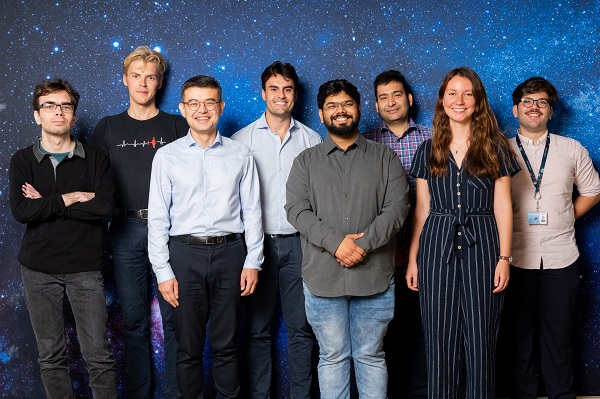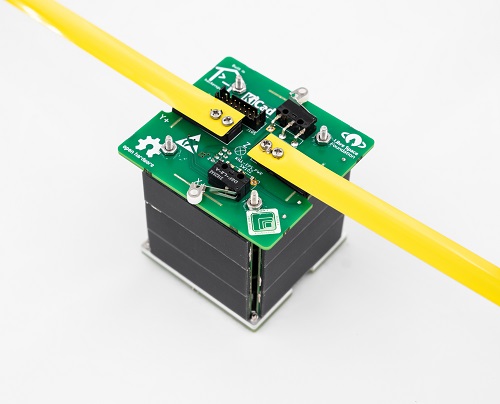 POQUITO team at SnT (3rd from left: Prof. Andreas Hein; 4th from left: Vittorio Franzese);
Credit: SnT - University of Luxembourg
POQUITO team at SnT (3rd from left: Prof. Andreas Hein; 4th from left: Vittorio Franzese);
Credit: SnT - University of Luxembourg
The University of Luxembourg is set to launch its first satellite on Tuesday 14 January 2025, between 19:49 and 20:46 (CET).
POQUITO (PocketQube for In-Orbit Technology Operations) will take off in a Falcon 9 rocket built by SpaceX from Vandenberg Air Force Base in California on the Transporter 12 mission.
POQUITO is a miniaturised satellite measuring 5x5x5 cm (about the size of a Rubik’s Cube) and weighing 185 grams. It is the University of Luxembourg's first fully owned satellite, developed and soon operated by the Space Systems Engineering (SpaSys) research group of the Interdisciplinary Centre for Security, Reliability and Trust (SnT).
POQUITO hosts a ChipSat, a printed circuit board payload measuring 5x5x0.2 cm functioning independently. According to the University of Luxembourg, the mission is to test communication links between the ChipSat and the PocketQube (both designed at the university).
Ahead of the launch, Chronicle.lu had the opportunity to speak with Prof. Andreas Hein, Head of SpaSys team at SnT, and Vittorio Franzese, postdoctoral researcher and team leader of POQUITO satellite mission at SnT, about this historic premiere.
Touching on their own involvement in the project, Prof. Hein explained his role was "to provide the necessary resources for the project in terms of people, finances, etc.". Vittorio Franzese "led the full mission development, acting as both a project manager and systems engineer, being part of a small group of researchers". The goal is to "achieve flight readiness [...] passing all the required steps to launch a satellite mission", which Dr Franzese acknowledged was no easy task. "As soon as POQUITO will be deployed in space, we will accomplish this, and not so many universities can claim the same". Prof. Hein added that, in addition to the successful launch of the satellite, the goal is to "get some data back from space". He continued: "Based on the things we learn from this mission we will be able to develop better and more ambitious space missions in the future. We hope that the team benefits from this experience and will have excellent career opportunities in industry and academia".
Elaborating on the decision for the University of Luxembourg to have its first fully owned satellite, and for SnT to develop it, Prof. Hein noted that the SnT works on various space technologies such as satellite communications, software and artificial intelligence (AI), with the SpaSys group seeking to "bring those technologies together to use them on an actual space mission". Dr Franzese added that the group was set up "with the objective of conducting fundamental and applied research in space systems". He elaborated: "In space, there is no better option than launching a satellite for applied research", thus "one of the main objectives of the group is to launch innovative space missions". This serves multiple purposes, namely: "going through the full development cycle of a space mission is the best educational tool for doctoral and master of science students within the university, which can study during classes and then learn by doing; going beyond pure numerical simulations and testing novel algorithms in flight is the best validation activity, as it happens for prototype cars in streets; and [showing that] this university is serious regarding space matters".
"It was only natural to develop our first satellite after the launch of our first payload AI4Space in 2023," said Prof. Hein. "Space is hard. It is a very hostile environment. When you work in our field, having launched something into space successfully is considered an 'entry ticket' to the 'club'. It opens possibilities for future collaborations with companies and space agencies."
On the choice of miniaturisation, Dr Franzese described this as "key for technologies". He offered the example of computers which have become smaller and more efficient over time. "The same is happening in space with small satellites. With POQUITO, we are going to test innovative technologies for satellite communication and spacecraft orientation control, all in a Rubik's cube sized satellite. If successful, future satellites will benefit from these advancements". Looking at other innovations linked to this project, Prof. Hein noted that the team are "testing satellite communication using light instead of radio waves. Light diodes are switched on and off, similar to Morse code to transmit signals from one part of the satellite to another". He also highlighted "the use of the Earth’s magnetic field to orient the satellite", adding that the team "developed a miniaturised technology for orienting our satellite without the need for rocket engines".
"Due to miniaturisation, we are also able to develop the satellite faster," clarified Prof. Hein. "Universities typically develop space missions during a three-to-eight-year period. Students who joined at the beginning of development have usually left the university at launch. We developed POQUITO within one year. We used a development process similar to the one SpaceX uses for its rockets. We rapidly built prototypes and tested those in order to improve the design. Students were able to experience an entire mission during their studies, which is unique".
Asked about the advantages and disadvantages based on design and choice of orbit, Dr Franzese said the main advantage of such a small satellite is that "we can quickly design, procure and test components, so to speed up the development process". On the other hand, "while large satellites can rely on redundancy onboard, meaning having the possibility of embarking multiple equal systems in case one of them fails, a compact satellite as POQUITO cannot have the privilege of such redundancy". The choice of orbit was "dictated mainly by space debris mitigation requirements", he explained. "As the number of satellites in space is increasing exponentially, we need to make sure that our mission is not causing harm to other satellites and achieves a quick time to re-enter in atmosphere. Therefore, we opted for a low-Earth orbit, at an altitude of 525 km, which is less congested than other orbits and assures a mission re-entry in a three-year timespan. Removing spacecraft for orbit is nowadays a must for space sustainability".
Prof. Hein added: "Satellites typically generate power by using solar cells. The larger the surface area covered by solar cells, the more power is generated. Due to the small size of POQUITO, the surface area covered by solar cells is relatively small and therefore, the power generated is limited". He noted that it uses "much less" power than a smartphone. However, this "also means that the amount of data the satellite can send down is limited. The orbit is such that the satellite will only have contact to the ground station for about 20 minutes about once per day".
In terms of the technological benefits expected to come out of this project for the public, Prof. Hein explained: "This type of technology using light for communication allows to either transmit vastly larger amounts of data compared to radio communication from space, for example, for livestreaming, or can be used for transmitting data consuming less energy".
Looking ahead, the next step is to launch POQUITO on the Transporter-12 mission onboard the SpaceX falcon 9 launcher. "Then, after a series of operations and orbital transfers thanks to our space carrier, we will be deployed in space in a window between seven to fourteen days after the launch. We will start communicating with our satellites from our ground station at SnT, and we will perform experiments for up to three years," Dr Franzese shared.
Indeed, the mission is expected to last three years, after which the satellite will re-enter "and completely burn" in the Earth's atmosphere, "freeing up our orbital position for future satellites", noted Dr Franzese. Prof. Hein assured: "Nothing will be left in space".
For members of the public wishing to follow the journey of the satellite, SpaceX will livestream the Falcon 9 launch, which can be followed on social media and on YouTube.

(POQUITO satellite; credit: SnT - University of Luxembourg)








